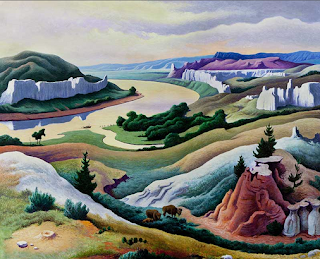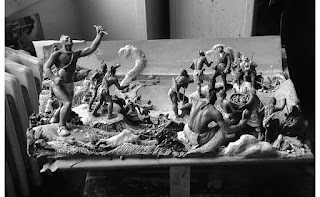Thomas Hart Benton (1889–1975) was at one time widely considered the leading painter of the United States. Today, he is virtually unknown. I see many valuable lessons for artists and writers in the rise and fall of Benton’s reputation.
 |
| Thomas Hart Benton, Self-Portrait |
At the height of his renown, Thomas Hart Benton was the first artist ever featured in a Time magazine cover story, in 1934. Art critic Thomas Craven wrote as late as 1958: “Thomas Hart Benton, secure in his eminence, has weathered the storms and caprices of popular and aesthetic tastes, and stands virtually in a class by himself…” Benton was in a position to become the Diego Rivera of the United States. Like Rivera, Benton went to Paris as a young artist during the Cubist era before World War I. In fact, Benton and Rivera knew each other in artistic circles in the French capital. Also like Rivera, Benton rebelled against the elite and rootless movements of modernism and returned to North America to paint murals that depicted the local history and politics of his country. Today, however, Rivera is enshrined as an iconic artist, while Benton is largely unheard of, even for many artists and art enthusiasts. I recently visited the Palace of the Legion of Honor in San Francisco to see one of Benton’s best-known canvases, Susanna and the Elders, in their permanent collection. I was told that the Fine Arts Museums of San Francisco had 24 works by Benton, and not one was on display. The almost total eclipse of Thomas Hart Benton’s reputation is even more surprising because he anticipated many directions in contemporary art:
- Benton rebelled against the empty abstractions of modernism in favor of a more representational and political practice of art.
- Benton condemned the New York-centered bias of the art world and moved back to his native Missouri to seek inspiration in settings not often represented in traditional painting.
- Benton worked with radical scholars outside the art world (including revisionist U.S. historian Charles Beard) to gain insight and information that he used directly in shaping his art.
- Benton incorporated images of African Americans and Native Americans in his paintings in ways that broke stereotypes.
To some degree, Benton’s innovative move back to Missouri and the Midwest, outside the coastal hubs of the art world, may be responsible for the current lack of awareness of his work. Some of Benton’s most monumental works he did for the Missouri State Capitol in Jefferson City; other are now housed in the Indiana University Auditorium in Bloomington, Indiana. One lesson here is that the reputation of an artist often has as much to do with geographic proximity to cultural centers as it does to the importance of the work. Benton’s standing in the art world also slid downwards during the rise of abstract expressionism in the 1950s, even though, ironically, Benton was a close mentor to the young Jackson Pollack. (The influence of Benton’s murals is still palpable in the scale and dynamism of Pollack’s abstract canvases.) Benton was also inconsistent in his portrayals of the truths of American history. He was far ahead of his time in showing how White settlers decimated Indian communities in works such as Aggression in his first major suite of murals, American Historical Epic, painted 1919–24.
 |
| Aggression, American Historical Epic |
Many of his portrayals of Native Americans have dignity and individuality, and are well researched. But Benton fell back on stereotypical images in a number of his murals, including the Indian offering the peace pipe to the gun-toting pioneer in Independence and the Opening of the West, painted for the Harry Truman presidential Library from 1959–62.
 |
| Detail from Independence and the Opening of the West |
Similarly, Benton depicted African Americans with nobility and pathos in Water Boy (1946) and Ten-Pound Hammer (1965).
 |
| Water Boy |
From my point of view, the lesson for artists and writers here is that if you go outside your own background for inspiration, make sure that you seek out honest and insightful feedback from members of the community you are representing. That is particularly true if, like Thomas Hart Benton, son of a U.S. congressman and grandson of a senator, you are fortunate enough to grow up with significant privilege. I believe that Thomas Hart Benton’s reputation as an artist has also not benefited from a revival because he used an odd technique in his work. To create murals with many figures in them, Benton sculpted three-dimensional models out of clay, or out of plasteline and wax.
Instead of painting directly from a live model, he often used those dioramas as visual notes for his compositions. Those lifeless models drained the vitality out of many of his paintings. Benton’s work also often has a cartoonish aspect, which might result from his retro fondness for egg tempera, rather than oils, which allow for a more painterly texture. The lesson here is, there is no substitute for living and breathing sources in our work as artists. Clay model Benton used to paint one of his murals
Ultimately the paintings of Benton that I find the most enduring are not his panoramic murals with dozens of figures, or his portraits of quaint, rustic characters, both of which were trademarks of his American Scene art. The paintings of Benton’s that move me the most are landscapes where the human element almost seems incidental, such as Lewis and Clark at Eagle Creek (1965), where a tiny boat is barely visible in a vast Western river valley.
 |
| Lewis and Clark at Eagle Creek |
I also admire The Boy (1950), where a young man waves goodbye to his farmer parents, presumably off to make his way in the big city.
 |
| The Boy |
Zack’s most recent book of poems, Irreverent Litanies
Zack’s most recent book of translations, Bérenice 1934–44: An Actress in Occupied Paris
Other posts of interest:
Getting the Most from Your Writing Workshop
How Not to Become a Literary Dropout
Putting Together a Book Manuscript
Does the Muse Have a Cell Phone?
Poetic Forms: Introduction, the Sonnet, the Sestina, the Ghazal, the Tanka, the Villanelle

No comments:
Post a Comment